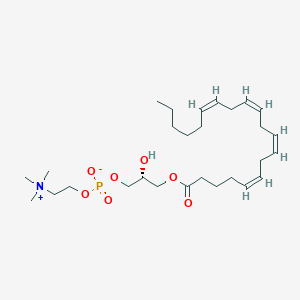Details of Metabolite
| Full List of Protein(s) Regulating This Metabolite | ||||||
|---|---|---|---|---|---|---|
| Hydrolases (EC 3) | ||||||
| GTPase KRas (KRAS) | Click to Show/Hide the Full List of Regulating Pair(s): 1 Pair(s) | |||||
| Detailed Information |
Protein Info
 click to show the details of this protein click to show the details of this protein
|
|||||
| Regulating Pair |
Experim Info
 click to show the details of experiment for validating this pair click to show the details of experiment for validating this pair
|
[1] | ||||
| Introduced Variation | Overexpression of KRAS | |||||
| Induced Change | LysoPC(20:4(5Z,8Z,11Z,14Z)) concentration: increase (FC = 2.74) | |||||
| Summary | Introduced Variation
|
|||||
| Disease Status | Lung cancer [ICD-11: 2C25] | |||||
| Details | It is reported that overexpression of KRAS leads to the increase of lysoPC(20:4(5Z,8Z,11Z,14Z)) levels compared with control group. | |||||
| Sulfatase sulf-1 (SULF1) | Click to Show/Hide the Full List of Regulating Pair(s): 1 Pair(s) | |||||
| Detailed Information |
Protein Info
 click to show the details of this protein click to show the details of this protein
|
|||||
| Regulating Pair |
Experim Info
 click to show the details of experiment for validating this pair click to show the details of experiment for validating this pair
|
[2] | ||||
| Introduced Variation | Knockdown (shRNA) of SULF1 | |||||
| Induced Change | LysoPC(20:4(5Z,8Z,11Z,14Z)) concentration: decrease (FC = 0.54) | |||||
| Summary | Introduced Variation
|
|||||
| Disease Status | Ovarian cancer [ICD-11: 2C73] | |||||
| Details | It is reported that knockdown of SULF1 leads to the decrease of lysoPC(20:4(5Z,8Z,11Z,14Z)) levels compared with control group. | |||||
| Transcription factor (TF) | ||||||
| R2R3-MYB (AN2) | Click to Show/Hide the Full List of Regulating Pair(s): 1 Pair(s) | |||||
| Detailed Information |
Protein Info
 click to show the details of this protein click to show the details of this protein
|
|||||
| Regulating Pair |
Experim Info
 click to show the details of experiment for validating this pair click to show the details of experiment for validating this pair
|
[3] | ||||
| Introduced Variation | Overexpression of AN2 | |||||
| Induced Change | LysoPC(20:4(5Z,8Z,11Z,14Z)) concentration: decrease (FC = 0.29) | |||||
| Summary | Introduced Variation
|
|||||
| Disease Status | Healthy individual | |||||
| Details | It is reported that overexpression of AN2 leads to the decrease of lysoPC(20:4(5Z,8Z,11Z,14Z)) levels compared with control group. | |||||
If you find any error in data or bug in web service, please kindly report it to Dr. Zhang and Dr. Mou.

